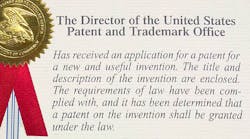Top Patent Issues Every Consumer Products Company Should Consider
Today’s consumer products companies have a wealth of competitive issues to face in managing their businesses in a global economy. Given these challenges, it is not surprising that addressing issues surrounding patent protection of their product lines may take a back seat to meeting manufacturing and sales goals. But for key products and product lines, ignoring or even putting off the patent process may spell disaster down the road.
The following areas are ones every consumer products company should consider to meld product introduction with patent protection and risk avoidance.
Protect the Look of Your Product
Design patents are often overlooked, yet they can be an important part of your intellectual property portfolio. The Apple v. Samsung lawsuit has raised the profile of design patents – Apple’s design patents played a large role in the jury’s billion dollar verdict.
A design patent protects the look or appearance of a product, as compared to the more popular utility patent which protects a product’s structural or functional aspects. A design patent can cover a product’s shape, a product’s surface ornamentation or even a particular arrangement of features. Design patents help protect aspects of your products where utility patents might fall short. For example, even if you own a utility patent that protects the functionality of your product, a competitor could offer a product look alike even though it may function differently. Without a design patent, you would not be able to stop your competitor’s sales, and consumers might be fooled into thinking that the competitor’s product functions like yours based solely on appearance.
Even in cases where a competitor sells a product that does infringe your utility patent, because of the inherent complexities of utility patents, infringement of your design patent may be easier to prove than utility patent infringement. In the Applecase, all it essentially took for the jury to find infringement was comparing Samsung’s phones to a relatively simple sketch in a patent.
Additional differences between design and utility patents can provide practical advantages. Design patent applications are far less expensive to prepare and move through the U.S. Patent Office more quickly than utility applications. And once issued as a patent, maintenance fees are not required to keep a design patent in force.
Design patents should be considered whenever a product has a new ornamental appearance which could be valuable in the marketplace.
Strategies for Growing Repeat Customers
The aftermarket for consumable products can be significant and is often more profitable than sales of the corresponding base product. Consumables—think disposable printer cartridges, razor blades and single-serving coffee pods—are extremely valuable because they provide a continuous source of revenue. However, this makes them highly susceptible to copying by competitors.
Fortunately, patent protection can help you capture your aftermarket and deter competitors from manufacturing generics. For example, to capture its ink stick market, Xerox has a vast patent portfolio that includes patents on the ink stick as well as its printer. Xerox even has protection for the ornamental design of the ink stick and on the chemical composition of the ink.
So, how can you, like Xerox, build a diverse patent portfolio to capture your consumable aftermarket? Ideally, through creative engineering, you want to design a consumable that is patentable itself or includes a patentable feature that permits it to be used with the non-consumable (for example, protecting the interlock). This provides the strongest protection, as competitors will be precluded from manufacturing or selling consumables that fit into your product. Next, consider adding combination claims, which protect the consumable in combination with an element of the non-consumable. You should also include design patents in your portfolio to protect the ornamental design of your consumable. Finally, to hinder direct competitors, obtain a patent on the non-consumable itself. By using these tips to build a strong patent portfolio, your competitors will think twice before entering your market space.
Pitfalls When Working With Prototype Developers and Beta Customers
Ideally, you should file patent applications to protect your product before you publicly or privately disclose the product. However, that is not always possible or practical. So what do you do if you haven’t filed any patent applications, but you need to prototype, test and/or show your product?
Prototyping- Generally, using a confidentiality agreement when contracting third-party manufacturers to make prototypes will help to prevent public disclosure of your product. However, under certain circumstances, even if a confidentiality agreement is in place, contracting a third-party manufacturer may still result in a loss of U.S. rights. One way to avoid this potential loss of rights is to make your prototype in-house and/or split up the manufacturing of prototype components among multiple suppliers and assemble the components in-house.
Testing- When using outside testers, e.g., friends, focus groups, etc., use a confidentiality agreement to help keep your product secret, but be sure to assess whether the product will actually be kept confidential. For example, if your testers are taking a prototype out in the open for test purposes, consider whether others will inevitably be exposed to the prototype. If so, think about whether testing could be done in a more controlled way, such as at your facility or only by employees or consultants who may be more trustworthy. If testing can’t be done in a reasonably secret way, patent applications should be filed prior to testing.
Showing the product publicly- Public disclosure of a product is necessary to make your business go, but some steps can be taken to preserve rights if you haven’t yet filed for patents. At trade shows, the risk of losing your patent rights can be reduced by showcasing the product’s functionality, but avoiding a description of how it actually works. If the product remains a “black box” and observers cannot deduce how the product works, rights to the undisclosed features will likely be preserved, at least for one year for U.S. filings. For those trusted or important potential customers, sharing product details under confidentiality agreement can be a reasonable option.
Managing Infringement Risk
An infringement lawsuit is not a situation that any company wants to face. Juries have awarded substantial damages to patentees in instances of infringement of consumer products, not to mention the millions spent on legal fees, the distraction to management, and the impact on future sales. In the recent Apple v. Samsung case, the jury awarded damages in excess of $1 billion after having found infringement of just three utility patents and four design patents.
What's worse, patent owners will often seek double or triple damages for willful infringement. While recent changes to the law make it more difficult for a patent owner to allege that you willfully infringed his or her patent, you may not always be saved from an unfavorable outcome if you do end up in court. Seeking advice from counsel early in the design phase can save you millions of dollars in damages and attorneys' fees, and avoid management distractions and disruptions to manufacturing, sales and customer goodwill. In fact, reliance on an opinion can be submitted as evidence against a claim of willful infringement, and consideration is given as to whether the opinion was authored by competent, independent counsel.
So, what can you do to reduce your risk of a costly infringement suit altogether?
- Review patents early-on to learn whether a particular field is blocked. Commonly referred to as a “landscape search,” you will be informed before your product is even conceived.
- Not every new product offering requires a thorough analysis. Rather, you should consider whether the new product meets a minimum threshold of sales volume or feature importance before embarking on a freedom to market analysis. Such products can be easily pulled from the market or redesigned should a blocking patent surface.
- For the more important product offerings, work with your designers and patent attorney to develop a list of key features to clear. Consider whether the feature is touted by your competition or whether there is any commercially viable alternative.
- With marketing and technical staff, develop a list of likely competitors and "key words" describing the features. Your attorney can conduct a targeted patent search that is more likely to uncover the most relevant patents.
- Your patent attorney will review the patents and flag any potential blocking patent. Further analysis of the patent claims and the public file history will inform whether the patent will be infringed. At this stage, working together, your designers and patent attorney can decide whether the product feature should be redesigned to avoid an otherwise problematic patent. If the patent claim is sweeping, your patent attorney, again with the help of your designers, will consider whether the patent is even valid over the prior art.
- In either case, your attorney will give you an opinion whether the patent is not infringed or is invalid. Importantly, your attorney should explain the basis of the opinion to you so that you can assess the risk, while considering the potential damages, the costs to redesign and the patent owner. Direct competitors are possibly more likely to complain of infringement.
Armed with this information, you can be more informed as to whether the risk of infringing a valid patent outweighs the upside from your new product offering. The key to success is being proactive early in the product design stage.





